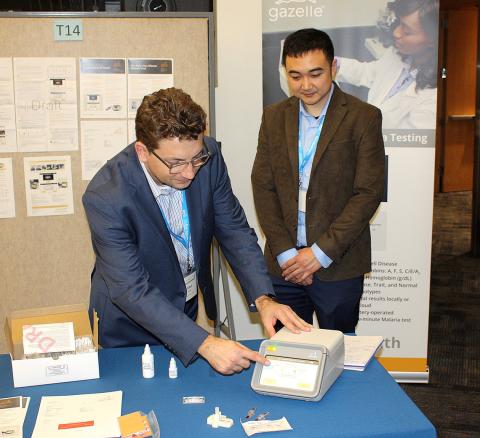Experts Team Up to Tackle Global Health Challenges

Photo: NIBIB
NIH recently hosted the IEEE Special Topic Conference on Healthcare Innovations and Point-of-Care (POC) Technologies, which highlighted how unmet clinical needs are driving technical solutions. The conference comes at a time when health care costs and access to care are of great concern in the U.S. At the same time, significant problems in developing countries and low-resource communities persist, such as high rates of sexually transmitted diseases and tuberculosis, as well as the need for better HIV diagnosis and treatment and women’s access to pre- and postnatal care.
The conference highlighted the important role for research, communication and transparency in developing point-of-care technologies. “Innovators, scientists, clinicians and patients need to work together to continually evaluate and refine the technology,” said program chair Dr. Diane Lawrence, an NIAID program officer. “Such a partnership ensures that the new technology is validated, measures what is really needed and actually makes a positive impact on human health.”
The conference featured a relatively new participant—artificial intelligence. Several keynote speakers as well as numerous new technologies showcased by poster presenters highlighted the AI built into their latest inventions.
In the opening keynote address, Dr. Mira Irons, chief health and science officer at the American Medical Association, spoke about the great promise of AI to support physicians and improve patient outcomes across the health care spectrum. However, she also warned of the potential risk to patients if AI tools for clinical decision-making are not grounded in rigorous evidence-based research and validation. She prefers to think of AI as “augmented intelligence” that focuses on AI’s assistive role, emphasizing the fact that its design enhances rather than replaces human intelligence.
Other prominent themes included the constant pursuit of smaller, cheaper and faster diagnostics for persistent global infectious diseases such as gonorrhea and chlamydia. Along with technical improvements, considerations such as integration of a device into the normal workflow of both modern health care facilities and clinics in the field were hot discussion topics.
Participants demonstrated, for example, how diagnosis and treatment could be sped by having women provide the vaginal swabs for gonorrhea and chlamydia testing themselves, in the waiting room lavatory. Having determined that women did not mind doing the self-swabbing, researchers found that the strategy resulted in the POC test being performed in time for the doctor to have the result in hand when first seeing the patient.
Such a protocol allows the doctor to prescribe treatment immediately to individuals testing positive for infection. In addition, the rapid result allows doctors to talk to patients about letting sexual partners know they should be tested and treated. It even allows patients to offer advice on how to broach the subject—a strategy that can dramatically reduce infection rates across entire regions.
A number of presenters described the critical challenge of turning an innovative technology built in the lab into a product that makes the harrowing journey to become a POC diagnostic used successfully in the field. The keys to success might be summed up as perseverance, personal sacrifice and partnerships—with a common sentiment being, “We thought we were at the end, but it was just the beginning.” The key message was that the blending of technology, assessment of clinical need, making it work in the field, manufacturing and commercialization takes multiple partnerships that should be assembled as early as possible.
“It is exciting to see the maturing of the development of POC technologies, approaches and strategies to get these innovative diagnostics into the field,” said Dr. Tiffani Lash, director of the NIBIB Point of Care Technologies Research Network and this year’s conference co-chair. “At the same time, it is equally exciting to see young investigators use potentially game-changing AI and machine learning to improve their device design as well as efficiently identify underserved communities where targeted diagnosis and treatment will have maximal impact.”
Lash noted that the conference started with a collaboration between NIBIB, the Institute of Electrical and Electronics Engineers (IEEE) and the IEEE Engineering in Medicine and Biology Society and has grown tremendously over the years.
